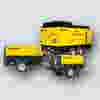Oil-free screw models
Oil-free compressors do not use any oil in the compression chamber, effectively removing the risk of contamination. When air purity is mission-critical for your business and even the smallest amount of contaminant could cause disruption to your process, even spoiling the end product, oil-free models offer peace of mind. For contaminant free air, trust oil-free screw compressors.
CompAir’s Ultima offers ISO-8573-1 Class Zero certified clean air, guaranteed. Ultima utilises low and high pressure dry screw airends which are individually driven by variable speed motors to offer unrivalled levels of energy efficiency. The ground-breaking design is compact, space-saving, and doesn’t compromise on performance. In fact, it offers a footprint 37% smaller than a conventional two-stage oil-free compressor!
Other products in our oil-free range include the DH series of water-injected screw compressors which offers 100% air purity to customers. In this model, high-quality water is used to lubricate, cool, and seal the compressor as a replacement for oil. By removing oil from the process entirely, you can guarantee a dry air output perfect for an array of stringent industries such as chemical, pharmaceutical, and food and beverage. For applications where compressed air comes directly into contact with the product, the DH series is a fantastic choice.
Another choice is the D series of fixed and regulated speed rotary screw dry compressors. These two-stage models have been designed to offer safe and reliable operation in the most demanding situations. Delivering state-of-the-art performance with low life cycle costs, the D series is a fantastic addition to any industrial compressor installation.













